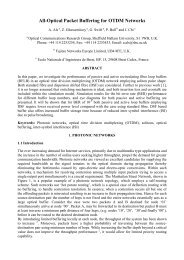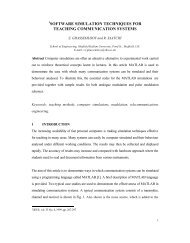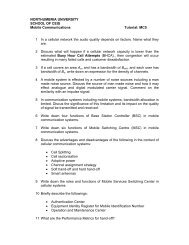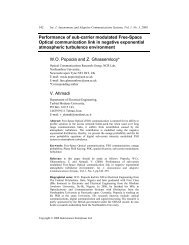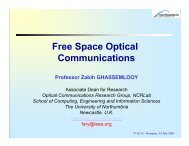A multiple switched beam smart antenna with beam shaping for ...
A multiple switched beam smart antenna with beam shaping for ...
A multiple switched beam smart antenna with beam shaping for ...
Create successful ePaper yourself
Turn your PDF publications into a flip-book with our unique Google optimized e-Paper software.
a time can be used. The block diagram of the proposed <strong>smart</strong><br />
<strong>antenna</strong> system is shown in figure 1. The fundamental<br />
components of the system are: the <strong>antenna</strong> array, <strong>multiple</strong><br />
<strong>beam</strong> <strong>for</strong>ming network (4x4 Butler Matrix) and the <strong>beam</strong><br />
<strong>shaping</strong> network. Each of the array columns has a gain of<br />
17.5dBi. The horizontal <strong>beam</strong> shape produced by the <strong>antenna</strong><br />
array is dependent upon the complex weights (magnitude and<br />
phase) applied to each array column. The complex weights are<br />
provided by the array feed network. The total feed network is<br />
realised by cascading a 4x4 Butler matrix <strong>beam</strong> <strong>for</strong>ming<br />
network and a <strong>beam</strong> <strong>shaping</strong> network. The <strong>for</strong>mer produces<br />
<strong>multiple</strong> narrow <strong>beam</strong>s each corresponding to a signal at one<br />
of the four <strong>beam</strong> ports and latter provides a combination of<br />
excitation (i.e. ‘‘<strong>beam</strong> blending’’) to each of the <strong>beam</strong> ports.<br />
The 4x4 Butler Matrix produces equal amplitudes and linear<br />
phase progressions to the array elements and the <strong>beam</strong><br />
<strong>shaping</strong> network provides simultaneous excitation of the <strong>beam</strong><br />
ports <strong>with</strong> relative amplitudes and phase. The relative<br />
amplitudes are dynamically changed by adjusting the three<br />
phase shifters <strong>with</strong>in the <strong>beam</strong> <strong>shaping</strong> network, (BSN). This<br />
results in the required complex weights at the array elements.<br />
It is a <strong>beam</strong> <strong>for</strong>ming network that uses a combination of 90°<br />
hybrids and fixed transmission line phase shifters to <strong>for</strong>m N<br />
simultaneous independent <strong>beam</strong>s from an N element <strong>antenna</strong><br />
array. It per<strong>for</strong>ms a spatial discrete Fourier trans<strong>for</strong>m and<br />
provides overlapping orthogonal <strong>beam</strong>s. When used <strong>with</strong> a<br />
linear array the Butler matrix produces <strong>beam</strong>s that overlap at<br />
3.9 dB below the <strong>beam</strong> maximum. A Butler matrix-fed array<br />
can provide <strong>beam</strong>s that can be used by a dedicated transmitter<br />
and/or receiver, or a single transmitter and/or receiver can be<br />
used and the appropriate <strong>beam</strong> can be selected using an RF<br />
switch. Any signal input into one of the butler matrix input<br />
ports will be divided equally among the output ports <strong>with</strong> a<br />
progressive phase delay. The passive Butler matrix will be<br />
dynamically controlled by the <strong>beam</strong> <strong>shaping</strong> network.<br />
Depending upon the communications traffic demand, a control<br />
algorithm can adjust the relative power divider/combiner ratio<br />
to blend all the <strong>beam</strong>s, or do <strong>beam</strong> switching or <strong>beam</strong><br />
broading <strong>for</strong> optimum service.<br />
B. Beam Shaping Network<br />
X<br />
X<br />
X<br />
X<br />
X<br />
X<br />
X<br />
X<br />
The <strong>beam</strong> <strong>shaping</strong> network is essentially a variable 4-way<br />
power divider/combiner that utilizes a 2-way variable power<br />
divider/combiner which drives two 2-way variable power<br />
dividers/combiners as shown in Figure 2.1. Each 2-way<br />
variable power divider/combiner is realised as shown in the<br />
network of figure 2.2.<br />
D D D D<br />
2 nd Feed<br />
Network<br />
To/From Butler Matrix Beam Ports<br />
Uplink<br />
Butler<br />
Downlink<br />
Butler<br />
Q<br />
Q<br />
Uplink<br />
BSN<br />
Downlink<br />
BSN<br />
Dipl<br />
Q<br />
Q<br />
Tran<br />
Figure 1 Smart Antenna system <strong>with</strong> <strong>beam</strong> <strong>shaping</strong><br />
Q<br />
III. BEAM FORMING AND BEAM SHAPING NETWORKS<br />
Q<br />
A. Beam Forming Network<br />
The Butler matrix has been chosen <strong>for</strong> this design because it is<br />
simple to realize compared to other <strong>beam</strong>-<strong>for</strong>ming networks.<br />
Input<br />
Figure 2.1 Beam Shaping Network<br />
<br />
Authorized licensed use limited to: University of Northumbria. Downloaded on April 20, 2009 at 06:29 from IEEE Xplore. Restrictions apply.




